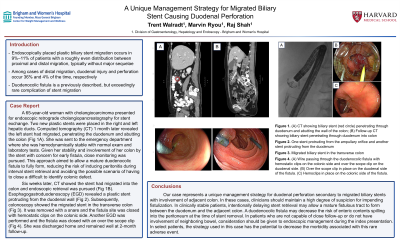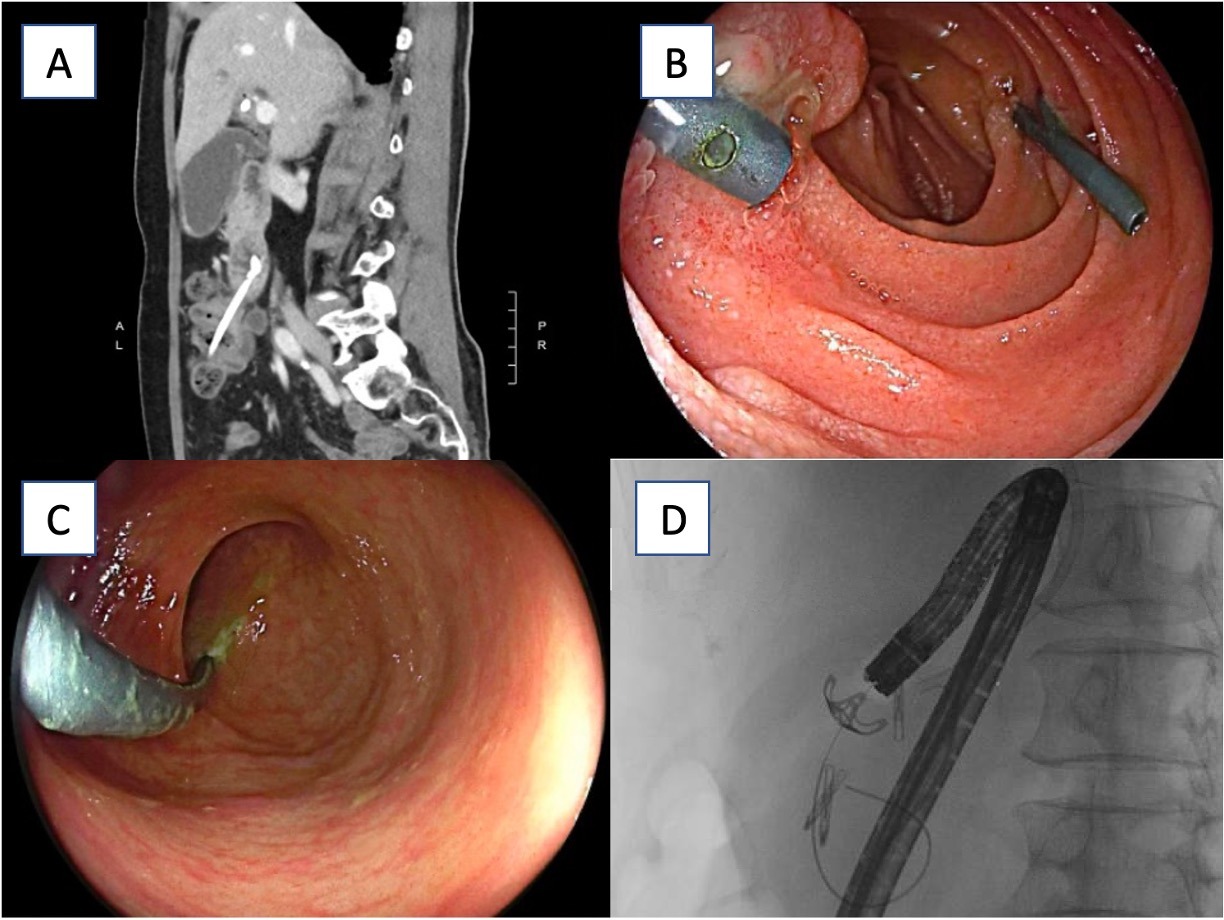Tuesday Poster Session
Category: Interventional Endoscopy
P3743 - A Unique Management Strategy for Migrated Biliary Stent Causing Duodenal Perforation
Tuesday, October 24, 2023
10:30 AM - 4:00 PM PT
Location: Exhibit Hall

Has Audio
- TW
Trent Walradt, MD
Brigham and Women's Hospital
Boston, Massachusetts
Presenting Author(s)
Trent Walradt, MD, Marvin Ryou, MD, Raj Shah, MD
Brigham and Women's Hospital, Boston, MA
Introduction: Migration of endoscopically placed plastic biliary stents occurs in 9-11% of patients. Among these patients, perforation is an even more rare adverse event. Herein we report a unique management strategy for this uncommon complication.
Case Description/Methods: A 65-year-old woman with cholangiocarcinoma presented for endoscopic retrograde cholangiopancreatography for stent exchange. Two new plastic stents were placed in the right and left hepatic ducts. Computed tomography (CT) 1 month later revealed the left stent had migrated, penetrating the duodenum and abutting the colon. She was sent to the emergency department where she was hemodynamically stable with normal exam and laboratory tests. Given her stability, close monitoring was pursued to allow a duodenocolic fistula to form and facilitate stent retrieval and avoid perforation.
Six weeks later, CT showed the stent had migrated into the colon and endoscopic retrieval was pursued (fig 1A). Esophagogastroduodenoscopy (EGD) revealed a plastic stent protruding from the duodenal wall (fig 1B). Subsequently, colonoscopy showed the migrated stent in the transverse colon (fig 1C). It was removed with a snare and the fistula site was closed with hemostatic clips on the colonic side. Another EGD was performed and the fistula was closed with an over the scope clip (fig 1D). She was discharged home and remained well at 2-month follow-up.
Discussion: Three cases of migrated biliary stents leading to duodenocolic fistula formation have reported management strategies including endoscopic stent retrieval without closure and surgical correction.
Our case represents a unique management strategy for duodenal perforation secondary to migrated biliary stents. In stable patients, delaying stent retrieval may allow a fistulous tract to form between the duodenum and the adjacent colon. Similar to the concept behind waiting four to six weeks before removing a percutaneous endoscopic gastrostomy tube after placement, a duodenocolic fistula may decrease the risk of enteric contents spilling into the peritoneum at the time of stent removal. The strategy employed in this case has the potential to decrease the morbidity associated with this rare adverse event.

Disclosures:
Trent Walradt, MD, Marvin Ryou, MD, Raj Shah, MD. P3743 - A Unique Management Strategy for Migrated Biliary Stent Causing Duodenal Perforation, ACG 2023 Annual Scientific Meeting Abstracts. Vancouver, BC, Canada: American College of Gastroenterology.
Brigham and Women's Hospital, Boston, MA
Introduction: Migration of endoscopically placed plastic biliary stents occurs in 9-11% of patients. Among these patients, perforation is an even more rare adverse event. Herein we report a unique management strategy for this uncommon complication.
Case Description/Methods: A 65-year-old woman with cholangiocarcinoma presented for endoscopic retrograde cholangiopancreatography for stent exchange. Two new plastic stents were placed in the right and left hepatic ducts. Computed tomography (CT) 1 month later revealed the left stent had migrated, penetrating the duodenum and abutting the colon. She was sent to the emergency department where she was hemodynamically stable with normal exam and laboratory tests. Given her stability, close monitoring was pursued to allow a duodenocolic fistula to form and facilitate stent retrieval and avoid perforation.
Six weeks later, CT showed the stent had migrated into the colon and endoscopic retrieval was pursued (fig 1A). Esophagogastroduodenoscopy (EGD) revealed a plastic stent protruding from the duodenal wall (fig 1B). Subsequently, colonoscopy showed the migrated stent in the transverse colon (fig 1C). It was removed with a snare and the fistula site was closed with hemostatic clips on the colonic side. Another EGD was performed and the fistula was closed with an over the scope clip (fig 1D). She was discharged home and remained well at 2-month follow-up.
Discussion: Three cases of migrated biliary stents leading to duodenocolic fistula formation have reported management strategies including endoscopic stent retrieval without closure and surgical correction.
Our case represents a unique management strategy for duodenal perforation secondary to migrated biliary stents. In stable patients, delaying stent retrieval may allow a fistulous tract to form between the duodenum and the adjacent colon. Similar to the concept behind waiting four to six weeks before removing a percutaneous endoscopic gastrostomy tube after placement, a duodenocolic fistula may decrease the risk of enteric contents spilling into the peritoneum at the time of stent removal. The strategy employed in this case has the potential to decrease the morbidity associated with this rare adverse event.

Figure: Figure 1: (A) Sagittal CT showing biliary stent penetrating through duodenum into transverse colon. (B) Endoscopic view of one stent protruding from the ampullary orifice and another stent protruding from the duodenum. (C) Migrated biliary stent in the transverse colon. (D) Endoscopic retrograde cholangiopancreatography showing guidewire passing through the duodenocolic fistula with hemostatic clips in place on the colonic side and an over the scope clip in place on the duodenal side.
Disclosures:
Trent Walradt indicated no relevant financial relationships.
Marvin Ryou: Boston Scientific – Consultant. Cook – Consultant. EnteraSense – Consultant. Fuji – Consultant. GI Windows – Consultant. Medtronic – Consultant. Olympus – Consultant.
Raj Shah indicated no relevant financial relationships.
Trent Walradt, MD, Marvin Ryou, MD, Raj Shah, MD. P3743 - A Unique Management Strategy for Migrated Biliary Stent Causing Duodenal Perforation, ACG 2023 Annual Scientific Meeting Abstracts. Vancouver, BC, Canada: American College of Gastroenterology.
